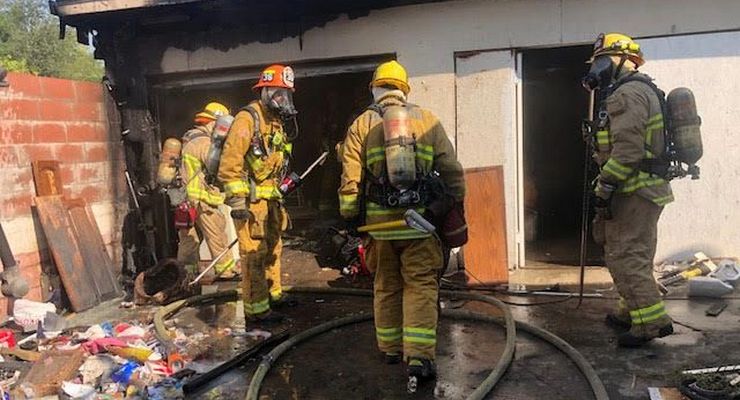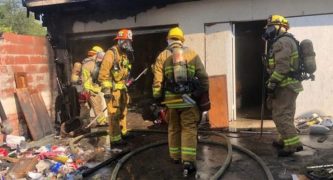
Record-setting wildfire activity has ravaged the West Coast over the past two months, and Pasadena itself was on evacuation warning basis for three weeks as a precaution against the destructive power of the still-burning Bobcat Fire which nearly wiped out Mt. Wilson.
Now the American Red Cross and the city of Pasadena want to shift your focus closer to home during National Fire Prevention Week, October 4 to 10, and ask you to pay attention especially to preventing kitchen fires.
This week, the Red Cross is urging everyone to test their smoke alarms and practice their escape plan as home fires continue during COVID-19.
Since February, the Red Cross has responded to more than 29,000 home fires across the country to help more than 128,000 people with urgent needs such as emergency lodging, financial assistance and recovery planning. The National Fire Protection Association (NFPA), which leads Fire Prevention Week with the theme, “Serve Up Fire Safety in the Kitchen,” says the home fires are the most frequent disasters in the country, and are most often caused by cooking.
The NFPA said there are important steps that homeowners can take to keep their families safe and prevent kitchen fires. Among these: always stay in the kitchen while cooking and if you have to leave, turn off the stove. Use a timer to remember to check the stove or oven regularly. De-clutter the area around the stove top to prevent items from catching on fire. Avoid distractions, such as your TV or electronic gadgets, while cooking.
“Home fires haven’t stopped during COVID-19, and neither has the need to prevent fire tragedies,” Trevor Riggen, senior vice president for Red Cross Disaster Cycle Services, said. “During Fire Prevention Week, test your smoke alarms and practice your escape plan to help protect you and your loved ones.”
A recent NFPA “Home Cooking Fires” report said fire departments in the U.S. responded to an estimated average of 172,900 home structure fires per year started by cooking activities between 2014 and 2018. These fires caused an average of 550 civilian deaths, 4,820 reported civilian fire injuries, and more than $1 billion in direct property damage per year.
Home fires caused by cooking peaked at Thanksgiving and Christmas, the report said. In many of these fires, ranges or cooktops were involved; these equipment were also involved in 87 percent of cooking fire deaths and 78 percent of cooking fire injuries.
More than one-quarter of the people killed by cooking fires were sleeping at the time, and more than half of the non-fatal injuries occurred when people tried to control the fire themselves, the NFPA said.
The report adds that households using electric ranges have a higher risk of cooking fires and associated losses than those using gas ranges. Unattended cooking was also the leading cause of cooking fires and casualties.
The NFPA also warned that the clothes you wear can become the first item to ignite in a cooking fire, so be careful about getting your dress close to the fire or heating element on your stove.
Escape plans in the home should be practiced often until everyone in the house can get out in less than two minutes, the Red Cross said. When preparing your escape plan, be sure to include at least two ways to exit every room in your home, and select a meeting spot at a safe distance away from your home; this could be a landmark such as a specific tree in your front yard, or even in your neighbor’s yard, as long as everyone knows where to meet when they exit your home.
Smoke alarms should also be tested frequently, and the batteries replaced at least once a year. An alarm should be placed on each level of your home, including inside and outside bedrooms and sleeping areas.
Be sure to also check the manufacturer’s date on your smoke alarms. If they’re 10 years or older, they need to be replaced because the sensor becomes less sensitive over time. As a parent, teach your children what a smoke alarm sounds like, and often talk about fire safety and what to do in an emergency.
Smoke alarms are just one of the reliable fire protection devices that should be in the home. Fire extinguishers should also be kept in several key areas in the home, including your kitchen, bedrooms, and garage. When seconds count, a standard, lightweight fire extinguisher can make all the difference in preventing a small fire from turning into a four-alarm blaze.
Carbon monoxide detectors may also be installed to alert you of dangerous levels of carbon monoxide gas in your home. If the alarm sounds, immediately move to a fresh-air location outdoors and call 911 for help. Don’t reenter the home until emergency personnel declare it is safe to do so.
Of course, if a fire is serious, always gather your family and pets first and get out of the house immediately before calling 911.
For more home fire prevention tips, visit www.redcross.org/get-help/how-














 0 comments
0 comments


